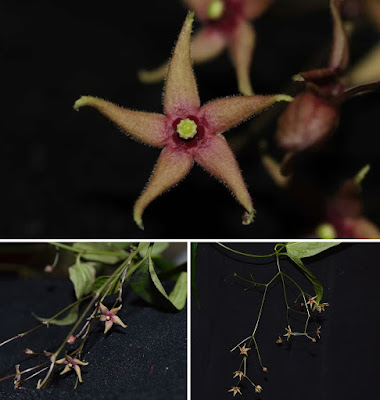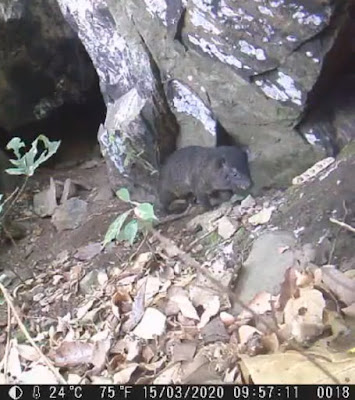[Most Recent Entries] [Calendar View]
Wednesday, June 16th, 2021
| Time | Event | ||||
| 1:25p | [Botany • 2021] Vincetoxicum emeiense (Apocynaceae: Asclepiadoideae: Asclepiadeae) • A New Species from Sichuan, China Abstract Vincetoxicum emeiense (Apocynaceae), a new species from Emeishan City, Sichuan Province, China, is described and illustrated. It is morphologically similar to V. hui and V. koi but can be distinguished by the glabrous stem, marginally finely ciliate with adaxially puberulent leaves and orange to purple corolla. Color photographs, conservation assessment and other relevant notes are also provided. Keywords: Mount Emei, morphology, new taxon, Tylophora, Eudicots Si-Yuan Zeng, Qiyi Yang, Jie Yu and Jian-Yong Shen. 2021. Vincetoxicum emeiense (Asclepiadeae, Asclepiadoideae, Apocynaceae), A New Species from Sichuan, China. Phytotaxa. 505(1); 56–62. DOI: 10.11646/phytotaxa.505.1.3 New Species of Milk Weed Family Found in Mount Emei | ||||
| 1:44p | [Mammalogy • 2021] Dendrohyrax interfluvialis • A New Species of Tree Hyrax (Hyracoidea: Procaviidae) from West Africa and the Significance of the Niger–Volta Interfluvium in Mammalian Biogeography
Abstract Tree hyraxes (Dendrohyrax) are one of only three genera currently recognized in Procaviidae, the only extant family in the mammalian order Hyracoidea. Their taxonomy and natural history have received little attention in recent decades. All tree hyrax populations of Guineo-Congolian forests of Africa are currently treated as a single species, Dendrohyrax dorsalis, the western tree hyrax, but many other groups of mammals distributed across this large biome have been shown to consist of several different species, each restricted to a distinct biogeographical region. We analysed variation in loud-call structure, pelage colour, skull morphometrics and mitochondrial genomes in populations across much of the range of D. dorsalis. This integrative approach uncovered considerable cryptic variation. The population found between the Niger and Volta Rivers in West Africa is particularly distinctive, and we describe it herein as a new species. Our study highlights the need to revise the taxonomy of the genus Dendrohyrax in light of modern systematics and current understanding of its distribution. It also adds to a growing body of evidence that the Niger–Volta interfluvium has a distinct meso-mammal fauna. Unfortunately, the fauna of this region is under major threat and warrants much greater conservation attention. Keywords: biogeography, cryptic species, Dahomey Gap, endemism, Mammalia, molecular systematics, morphometrics, skull, speciation, vocalizations
John F. Oates, Neal Woodman, Philippe Gaubert, Eric J. Sargis, Edward D. Wiafe, Emilie Lecompte, Françoise Dowsett-Lemaire, Robert J. Dowsett, Sery Gonedelé Bi, Rachel A. Ikemeh, Chabi A. M. S. Djagoun, Louise Tomsett and Simon K. Bearder. 2021. A New Species of Tree Hyrax (Procaviidae: Dendrohyrax) from West Africa and the Significance of the Niger–Volta Interfluvium in Mammalian Biogeography. Zoological Journal of the Linnean Society. zlab029. DOI: 10.1093/zoolinnean/zlab029 A new study in the Zoological Journal of the Linnean Society co-authored by Yale anthropologist Eric Sargis finds that the barking hyraxes are a separate species from their shrieking neighbors. The newly described species, Dendrohyrax interfluvialis, populates the wet and dry forests that lie between the two rivers in coastal regions of southeastern Ghana, southern Togo and Benin, and southwestern Nigeria. Barks in the night lead to the discovery of new species |
| << Previous Day |
2021/06/16 [Calendar] |
Next Day >> |











